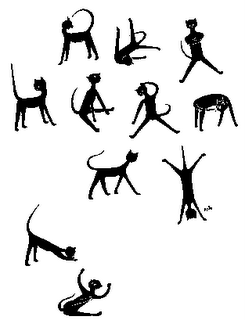
FUNNY FEELING
Friday, July 28, 2006
Bruno Munari: Autodidact

I learned a new word today and that is "autodidact". It means someone who is self-taught. I found it incredibly inspiring that Bruno Munari was entirely a self-taught artist. Lisa Nugent introduced his work to us in first term and my interest quickly grew into a fascination of his work and his philosophy. In hindsight, our Superstudio could be indirectly influenced by his playfulness and his process of making things. Munari was involved with children's book and teaching children about art. The monsters, wood boxes, and wooden mobiles suddenly become more meaningful in my own reasoning. As an inventor of "useless machines" (a phrase he coined himself), Munari would have been pleased.
"Da cosa nasce cosa" (one thing leads to another).--Bruno Munari
Saturday, July 15, 2006
TANGO by Zbig Rybczynski

(images from Zbigvision.com and Midnight Eye)
In "Tango", the use of small space creates more opportunities for interaction than larger spaces. The technique of using the imaginary space off-screen is inversed so that no single person is significant in the shot. It is the interaction between them bump up against each other that creates the drama. No narrative is necessary in the piece because the viewer creates their own version of what is occurring in the interactions. Each character interacts with the room by performs an action. The manner they enter the frame and exit. The "dance" they perform around each other. Each of these interactions build a drama that would usually happen in a much larger space or with less characters.
Similarly, Yasujiro Ozu also plays off the offscreen space and utilizing interactions in a small space. In his "tatami" shots, the camera never moves while characters move in and out of the shot. They can also be moving along on different planes of the shot. The father reading the newspaper sitting in the foreground while the mother is in the background preparing dinner.
With interaction design, you can choose the timing and positioning of the characters. Good interaction design also uses the techniques of the stage. While the user is the director, actors shouldn't be on the stage unless they’re called upon. For example, navigation shouldn't appear unless the user is ready to move away from the page.
In both examples, the stage is important and players move in and out of the stage. But what happens offscreen could be just as interesting. How can that be shown? What if you can remove characters off the stage? Would that change the narrative? What if it's not a small tenement room but a tatami room? Does that change the context?